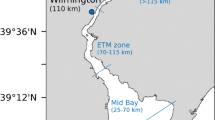Abstract
Phytoplankton development in river systems is under the control of various meteorological, hydrological, chemical and biological factors. Because of the continuity of the aquatic systems which progress from headwaters to the largest rivers, the interplay of these control factors can only be understood at the scale of the entire drainage network. The RIVERSTRAHLER Model, based on the concept of stream-order, has been established for that purpose. It has been applied here on two rivers from the Seine basin: rivers Marne and Oise. It is shown that hydrological factors determine the time of onset, and the position within the drainage network, of the spring algal bloom. Phosphorus availability, when limiting, controls the intensity of the bloom. During summer, top-down control, linked to grazing and other causes of mortality, has a marked impact on algal dynamics.
Similar content being viewed by others
References
AESN, 1991. Memento statistique. Agence de l'Eau Seine Normandie, Nanterre (France), 127 pp.
Billen, G. & P. Servais, 1989. Modélisation des processus de dégradation bactérienne de la matiére organique en milieu aquatique. In Bianchi et coll. (eds), Micro-organisms dans les écosystèmes océaniques. Masson, Paris: 219–245.
Billen, G., S. Dessery, C. Lancelot & M. Meybeck, 1989. Seasonal and interannual variations of nitrogen diagenesis in the sediments of a recently impounded basin, Biogeochemistry 8: 73–100.
Billen, G., 1991. Protein degradation in Aquatic Environments. In R. Chrost (ed), Microbial Enzyme in Aquatic Environments. Springer Verlag, Berlin: 123–143.
Billen, G., 1993. The PHISON River system: a conceptual model of C, N and P transformations in the aquatic continuum from land to sea. In Wollast, R., Mackenzie, F. T. & Chou, L., (eds), Interactions of C, N, P and S biogeochemical cycles and Global Change. NATO ASI Series 14 Springer Verlag, Berlin, 521 pp.
Billen, G., J. Garnier, M. Poulin & P. Servais, 1993. Un exemple d'application des modéles de fonctionnement de l'écosystème élaborés par le PIREN-Seine. Evaluation de l'impact sur la qualité de l'eau du traitement de l'azote et du phosphore dans les effluents urbains. In Billen, G. & Allardi, J. (eds). PIREN-Seine, Rapport de Synthèse 1989–1992. Vol. I. Le fonctionnement de l'écosystème: analyse des processus et modélisation. CNRS. Paris, VIII: 1–30.
Bultot F. & G. Dupriez, 1976. Conceptual hydrological model for an average-sized catchment area. J. Hydrol. 39: 251–292.
Canter, H. M. & J. W. G. Lund, 1948. Studies on plankton parasites. 1. Fluctuations in numbers of Asterionella formosa in relation to fungal epidemics. New Phytol. 47: 236–261.
Décamps, H. & R. J. Naiman, 1989. L'écologie des fleuves. La Recherche, 208: 310–319.
Garnier, J. & G. Billen, 1994. Ecological interactions in a shallow sand-pit lake (Créteil Lake, Parisian Basin, France): a modelling approach. Hydrobiologia 275/276: 97–114.
Garnier, J., G. Billen, P. Hanset & M. Coste, 1993. Développement algal et eutrophisation dans le réseau hydrographique de la Seine. In G. Billen &J. Allardi (eds.), PIREN-Seine, Rapport de Synthèse 1989–1992. Vol. 1. Le fonctionnement de l'écosystème: analyse des processus et modélisation. CNRS. Paris.
Hammer, M. & K. A. Mac Kichan, 1981. Hydrology and quality of water resources. J. Wiley & Sons, Inc., 280 pp.
Jassby, A. D. & C. R. Goldman, 1974. Loss rates from a lake phytoplankton community. Limnol. & Oceanogr. 19: 618–627.
Lancelot, C. & C. Billen, 1985. Carbon-Nitrogen relationship in nutrient metabolism of coastal marine ecosystem. In H. W. Jannash & P. J. Leb Williams Advances in Aquatic Microbiology. Academic Press London, 3: 263–321.
Lancelot C., C. Veth & S. Mathot, 1991. Modelling ice-edge phytoplankton bloom in the Scotia-Weddell Sea sector of the Southern Ocean during spring 1988. J. Mar. Systems 2: 333–346.
Lund, J. W. G., 1971. The seasonal periodicity of three planktonic desmids in Windermere. Mitt. int. Ver. Theor. Angew. Limnol. 19: 3–25.
Moloney, C. L. & J. G. Field, 1989. General allometric equations for rates of nutrients uptake, ingestion and respiration in plankton organisms. Limnol. Oceanogr. 34: 1290–1299.
Strahler A. H., 1957. Quantitative analysis of whatershed geomophology. Geophys. Union Trans. 38: 913–920.
Suttle, C. A., A. M. Chan & M. T. Cottrell, 1990. Infection of phytoplankton by viruses and reduction of primary productivity. Nature 347: 467–469.
Testard, P., 1990. Eléments d'écologie du lamellibranche invasif Dreissena polymorpha (Pallas). Etude de la dispersion des larves en région parisienne et de leur fixation. Réponses à la désoxygénation de l'eau. Ph.D. Thesis. University P. and M. Curie (Paris 6), France, 358 pp.
Testard, P., R. Pourriot, A. Miquelis, A. & C. Rougier, 1993. Fonctionnement de l'écosystème fluvial: organisation et role du zooplancton. In G. Billen & J. Allardi (eds.). PIREN- Seine, Rapport de Synthèse 1989–1992. Vol. 1. Le fonctionnement de l'écosystème: analyse des processus et modélisation. CNRS. Paris, II: 1–38.
Vannote, R. L., G. W. Minshall, K. W. Cummins, J. R. Sedell & C. E. Cushing, 1980. The River Continuum Concept. Can. J. Fish. aquat. Sci. 37: 130–137.
Author information
Authors and Affiliations
Rights and permissions
About this article
Cite this article
Billen, G., Garnier, J. & Hanset, P. Modelling phytoplankton development in whole drainage networks: the RIVERSTRAHLER Model applied to the Seine river system. Hydrobiologia 289, 119–137 (1994). https://doi.org/10.1007/BF00007414
Issue Date:
DOI: https://doi.org/10.1007/BF00007414




